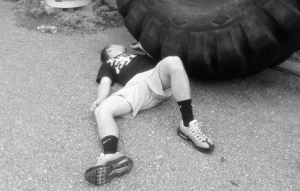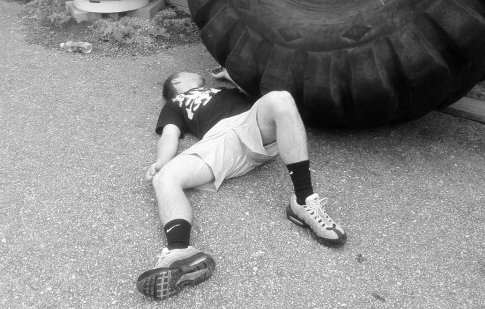“So you want me to push this thing up and down the runway a dozen times?” “Yeah.” “How is that going to better prepare me for my sport?” “It’s not, but watching you throw up is going to be awesome.” Sometimes I think that conversation happens, silently, between coach and athlete upon programming prowler suicides. [...]
 “So you want me to push this thing up and down the runway a dozen times?”
“So you want me to push this thing up and down the runway a dozen times?”
“Yeah.”
“How is that going to better prepare me for my sport?”
“It’s not, but watching you throw up is going to be awesome.”
Sometimes I think that conversation happens, silently, between coach and athlete upon programming prowler suicides. But coach always wins out because the general consensus says anything that makes us puke or pass out must be good, and hard gut-wrenching work that makes us better.
But it doesn’t.
Now, I have nothing against pushing a prowler around to raise the heart rate a bit. I think it’s a great tool. But prowler suicides in the name of prowler suicides is asinine.
“But it’s conditioning!”
I’m sure that’s the rebuttal I’ll hear. Upon wherein I’ll ask, “what does conditioning mean?” I probably won’t get a response, but if I did, I’m sure it would be something along the lines of “working until the vomiting sensation creeps into the back of the throat.” But here’s why that’s wrong.
Not many sports involve a few minutes of effort followed by a monumental mental and physical collapse. Sidney Crosby doesn’t play one long shift until utter exhaustion and call it quits. Larry Fitzgerald doesn’t run one route and collapse on the sideline. Ronaldo doesn’t make one run and pull himself from the game. Pujols doesn’t take one at bat and then lounge in the dugout eating sunflower seeds for the rest of the game.
Most athletes can’t afford to blow their load in a game, let alone during one play. And yet this is what prowler suicides teach us to do. More troubling is that they have no specificity to the energy systems involved in sports. They aren’t conditioning. Maybe they are shampoo?
I’ll estimate the average prowler suicide to last one minute. Just an estimate. And I’ll also assume no rest. So let’s look at why this sucks.
Not many sports involve one minute of a continued near-maximal effort. Larry Fitzgerald goes all out for about five or six seconds before he can relax a bit. Ronaldo, although jogging around a lot, only goes all out when he’s making a run. Pujols, well, he swings a bat and runs when he has to, which is very sporadic—never lasting more than a few seconds. Sidney Crosby may benefit the most, considering hockey shifts average 45 seconds. But even then, the intensity of that 45 second shift is one that needs to be repeated over the length of the game.
So tell me how prowler suicides prepare any of those athlete’s for the energy demands they encounter in their sport.
You can’t.
The prowler suicides, as far as I’m concerned, is about as sensible as CrossFit. Yes, I went there. It’s a little safer, for all intents and purposes, but the same logic. The only reason I’d use prowler suicides is to develop an athlete’s mentality. Or for punishment.

That’s not to say the prowler is bad. It isn’t as long as you respect the specifics of the sport. But most don’t. And if you’re an everyday guy training for the fun of it, then go ahead and push that thing across town and have fun doing it. There’s nothing wrong with that. Absolutely nothing. But when people start using it for “conditioning” purposes without regard for specific energy systems that need developed, we have problems.
So can we stop admiring prowler suicides? Can we realize that “conditioning” is, perhaps, the worst concept in existence? Can we honestly evaluate what an athlete needs and tailor their training in a sensible, logical, and planned manner?
My guess is no. But it’s worth a shot.
Share your hatred below.
TL;DR
Athletes that do prowler suicides without regard for specific energy system development are jackasses.
Photo Credit: Alliance Training Center, T-Nation
